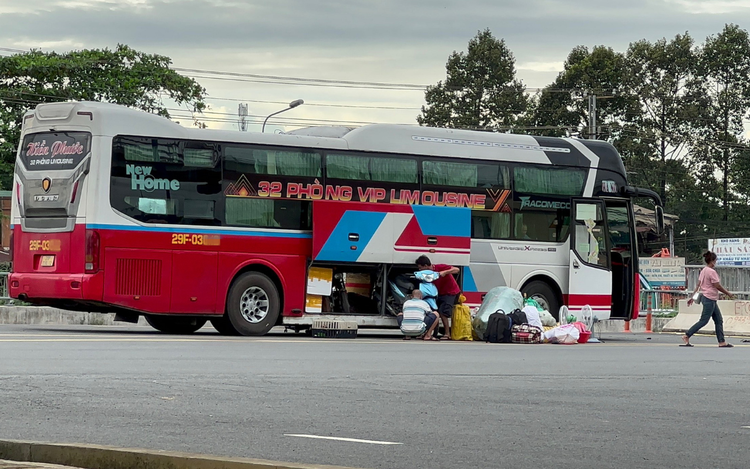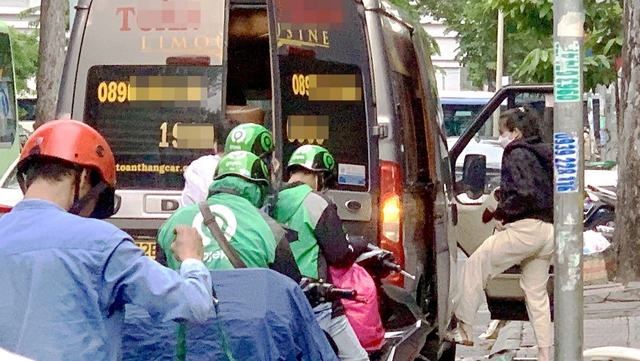
A sleeper bus picks up passengers in front of the entrance of Ho Chi Minh City's new Mien Dong (Eastern) Bus Station. Photo: Thu Dung / Tuoi Tre
The proposal is aimed at preventing these vehicles from stopping along urban corridors to pick up and drop off passengers, according to Nguyen Kien Giang, deputy head of the division.
Since the partial ban took effect on January 10, most transport operators and drivers have complied with adjusted routes.
However, unauthorized pick-up and drop-off activities have intensified.
Numerous illegal parking spots have sprung up across the inner city, including locations on Le Co Street, at the intersection between National highway 1, Road 7, and Road 8 in former Binh Tan District, and near petrol stations in former Thu Duc City.
The proposed round-the-clock ban would maintain the existing geographical boundary for restricted zones, bordered by major roads such as National Highway 1, Nguyen Van Linh, Vo Chi Cong, Nguyen Thi Dinh, Dong Van Cong, Mai Chi Tho, and Ha Noi Highway.
Sleeper buses would still be allowed to operate on the ring roads and access major bus stations, provided they follow approved routes.
The department is currently collecting feedback on the proposed ban from several relevant units, Giang said.
While many back the 24-hour prohibition, some believe it may be premature. As many as 13 units have yet to submit opinions, so the department is awaiting consensus before presenting a final recommendation to the municipal People’s Committee.
Local police were urged to step up patrols and enforce violations more strictly, particularly against sleeper buses operating in prohibited zones and stopping illegally.
Assoc. Prof. Dr. Vu Anh Tuan, head of the Vietnamese-German transportation research center at Vietnamese-German University, emphasized the need of eradicating illegal bus operations to ensure traffic safety and fair market competition.
People often choose what is convenient, so cracking down on illegal stops is difficult.
However, a round-the-clock sleeper bus ban is an essential step, and it must be enforced thoroughly, he said.
Dr. Tuan called for a two-pronged strategy: improving shuttle services and leveraging GPS data from buses to identify violations and issue automatic penalties.
Echoing the view, Dr. Chung Thanh Tien, an economic expert, said that the proposed expanded ban is both legal and necessary.
He noted that sleeper buses often illegally enter downtown areas to pick up passengers, disrupting traffic and undermining the city’s formal transport network.
He shared that sleeper buses operate on Nguyen Thai Binh Street all day despite regulations.
In one case, an officer reportedly conducted an inspection and immediately revoked the license of a violating operator, proof that assertive enforcement can yield results.
However, once patrols eased, violations resurged, especially during late-night hours.

A passenger bus stops and picks up a passenger on Nguyen Thai Binh Street in downtown Ho Chi Minh City, July 26. Photo: T.T.D. / Tuoi Tre
In cities worldwide, sleeper buses are forbidden from entering downtown areas.
In the suburban areas, they build large bus stations where sleeper buses are concentrated, and passengers can take trains or public transport to travel into the city center.
For Ho Chi Minh City to follow this model, enforcement must be consistent, he said.
Nguyen Hoang Huy, director of the new Mien Dong Bus Station, revealed that many passenger transport operators have abandoned the station to run illegally to stay afloat financially.
Just outside the station, unlicensed buses operate openly, picking up passengers while evading police by fleeing down Nguyen Xien, Hoang Huu Nam Streets or toward Dong Nai Bridge, Huy said.
His station threw its support behind the round-the-clock ban proposal, calling for it to be paired with improved infrastructure, surveillance, and public transit access.
The issue goes beyond sleeper buses.
Smaller vehicles with 16-29 seaters frequently operate unregulated passenger services under the guise of cargo transport.
Passengers choose convenience, while operators exploit lax enforcement, so bus stations remain empty, he said.
At nearly 11:00 pm on Chu Van An Street, passengers gather at a private office to board a sleeper bus.
When the bus arrives, within minutes, luggage is stowed, passengers board, and the bus speeds off.
Similar scenes play out at unofficial stops along National Highway 13 and Dinh Bo Linh Street, areas clearly marked with no-parking signs but bustling with activity.
Local vendor Pham Van Hung said the new bus station has been open for some time, but hardly anyone uses it. Instead, crowds continue to flock to the makeshift terminals outside.


Max: 1500 characters
There are no comments yet. Be the first to comment.